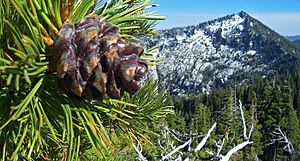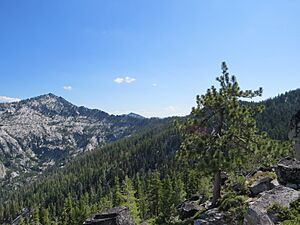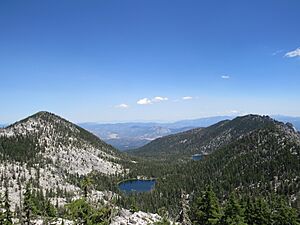Russian Wilderness facts for kids
Quick facts for kids Russian Wilderness |
|
|---|---|
|
IUCN Category Ib (Wilderness Area)
|
|
 |
|
| Location | Klamath National Forest, Siskiyou County, California |
| Nearest city | Eureka, California |
| Area | 12,700 acres (51 km2) |
| Governing body | United States Forest Service / United States Department of Agriculture |
The Russian Wilderness is a special protected area in northern California. It covers about 12,000 acres (4,900 km2) and is located northeast of Eureka. This amazing place is part of the Klamath National Forest in Siskiyou County and is looked after by the US Forest Service. It became a protected wilderness in 1984, thanks to a law called the California Wilderness Act.
This wilderness protects the Russian Mountains, which are part of the tall Salmon Mountains. These mountains are made of cool rocks like metamorphic rock and granite. You can find over twenty lakes here, all at different heights. Important rivers like the Scott River and North Fork Salmon River also start in this area.
The Russian Wilderness is connected to two other wilderness areas: the Trinity Alps Wilderness to the south and the Marble Mountain Wilderness to the north. Together, they create a long, almost unbroken path for animals. This path is super important for wildlife, especially for black-tailed deer that travel through it. The Russian Wilderness is part of one of the biggest areas in northwestern California with almost no roads!
The land here goes from about 2,500 feet (760 m) high all the way up to Russian Peak, which is the highest point at 8,196 feet (2,498 m) tall.
Contents
Plants and Animals of the Russian Wilderness
The Russian Wilderness is home to some really special trees that are rare in California. These include the subalpine fir and Engelmann spruce. Scientists became very interested in this area in the 1970s because of the amazing variety of trees found here.
Imagine finding 17 different types of cone-bearing trees (conifers) in just one square mile! These include:
- Foxtail pine
- Whitebark pine
- Western white pine
- Jeffrey pine
- Ponderosa pine
- Lodgepole pine
- Sugar pine
- White fir
- Shasta fir
- Subalpine fir
- Engelmann spruce
- Brewer spruce
- Mountain hemlock
- Douglas-fir
- Incense-cedar
- Common juniper
- Pacific yew
Later, an 18th conifer, the western juniper, was also found here.

You can also find rare plants like the Siskiyou fireweed and several types of lousewort (Pedicularis). The rare Siskiyou phacelia (Phacelia leonis) was seen in 1988. This plant has pretty bell-shaped blue-purple flowers that bloom in summer. It likes to grow in a special kind of soil called serpentine soil.
The wilderness is a safe home for many animals. You might see American black bears, deer, Douglas squirrels, California quail, and even rattlesnakes. Some less common animals that live here include fishers, American martens, wolverines, northern pileated woodpeckers, North American beavers, California valley coyotes, and North American cougars. If you like fishing, the lakes and streams have rainbow trout, eastern brook trout, and brown trout.
How the Mountains Were Formed
The Russian Wilderness has amazing granite mountains that were shaped by glaciers a very long time ago. This makes the landscape look a lot like the famous Sierra Nevada mountains. You can see cool features like cirques (bowl-shaped hollows) and U-shaped glacial valleys. Along the edges of the wilderness, you'll find a chain of dark metavolcanic rocks, which are also very interesting!
Fun Things to Do in the Wilderness
The Pacific Crest Trail is a famous long-distance hiking trail that goes through the Russian Wilderness for about 18.5 miles (29.8 km) along the Salmon Mountain crest. Another trail, the Bigfoot Trail, also passes through for about 5 miles (8.0 km).
Because the wilderness isn't super huge, you can often reach its most beautiful spots in less than two hours of hiking or horseback riding. In winter, if there's snow, you can go skiing or snowshoeing! There are four cirque basins (areas shaped like bowls by glaciers) that are great for telemark skiing. The main rivers, the North Fork Salmon and Scott rivers, are good places to find rainbow trout and steelhead fish.
Nearby Roadless Areas
There are three separate areas next to the wilderness that don't have roads. These areas cover about 16,800 acres (6,800 km2). They have old old-growth trees like oak and madrone. Like the wilderness itself, these areas also have landscapes shaped by glaciers, with U-shaped valleys and granite rocks.




